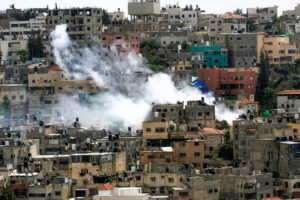As Gaza war rages, West Bank faces violent collective punishment

Smoke rises during an Israeli military raid in the occupied West Bank city of Tulkarm, 19 October 2023
Fatima AbdulKarim reports in +972 on 19 October 2023:
On Tuesday night [17 October], the initial shock, mourning, and sorrow that has overshadowed the occupied West Bank since October 7 evolved into anger and outrage, predominantly directed at the Palestinian Authority (PA), following the explosion at the Al-Ahli Arab Hospital in Gaza. Tensions flared as protests against the PA’s stance on Gaza turned violent; PA security forces responded with gunfire and tear gas, prompting militants in Jenin to open fire in turn. A 12-year-old, Razan Nasrallah, was killed in the city in the resulting clashes, and several others were injured.
Although the Al-Ahli Hospital bombing was the immediate catalyst for the protests, it awoke long-running popular discontent and dissatisfaction with the PA’s silence on the ongoing war in Gaza. Protesters shouted slogans calling for the Palestinian regime to be toppled, and for Palestinian President Mahmoud Abbas to step down.
That Abbas walked away from his planned meeting in Jordan with U.S. President Joe Biden, and instead returned immediately from Amman to Ramallah after the hospital explosion, was not enough to placate the popular uproar. Several dozen Palestinians in Nablus continued the protests on Wednesday, and were met by tear gas and gunfire from PA officers, bringing the number of injuries, according to medical sources, to around 40. The PA’s health ministry has not reported the injuries resulting from the protests.
Prior to the hospital bombing, there had been an almost tangible stillness in Palestinian cities in the West Bank. On the heels of the Hamas-led attack against Israel on October 7, and Israel’s devastating response in the Gaza Strip, the Israeli army has imposed a stringent lockdown and movement restrictions on Palestinians in the occupied territory.
The lockdown, which is intended to keep the West Bank firmly segregated as Israel carries out its war, has made Palestinians here feel as if they are reliving the days of the Second Intifada in the early 2000s — a glimpse of which was also seen Tuesday night. Back then, as today, the Israeli military imposed a cantonized strategy across the West Bank, closing off roads with makeshift gates and checkpoints to separate rural villages from larger towns and cities, and those cities from one another. The Israeli authorities also banned Palestinians from driving on many roads connecting the northern and southern West Bank, most infamously through what is known locally as the “Container Checkpoint” near Bethlehem, which is still in operation to this day.
As a result, a sense of terror and exhaustion has taken root among many Palestinians in the West Bank these past two weeks, a consequence not only of the lockdown but also of the profound changes that have occurred this month, which seem to have fundamentally altered the political landscape.
Since Hamas’ attack, the number of extrajudicial killings, displacements of local communities, and settler attacks in the West Bank have skyrocketed, and are almost certain to go unpunished. As of Thursday, at least 75 Palestinians have been killed and over 1,300 injured in the West Bank since Oct. 7, according to the PA’s health ministry. Six of the victims were killed by armed settlers in Qusra and At-Tuwani.
